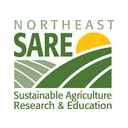







Note: This project was completed in 2016. The valuable resources produced are now being hosted by the Northeast Pasture Consortium
Forage and Pasture Species Description and Selection
The following are materials and some links about the description and selection of our major forages used in the Northeast. If you have additional materials, favorite websites or presentations that you have made pretaining to this, please send them to me and I'll post them.
Factsheets, Bulletins and Articles| Northeast SARE is a regional program of the nationwide SARE which offers competitive grants to projects that explore and address key issues affecting the sustainability and future economic viability of agriculture. The program is authorized under Subtitle B of Title XVI of the Food, Agriculture, Conservation, and Trade Act of 1990. It's wider mission is to advance, to the whole of American agriculture, innovations that improve profitability, stewardship, and quality of life by investing in groundbreaking research and education. For more information go to, http://www.nesare.org/ |